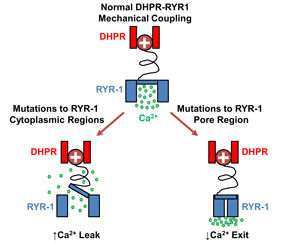 The type I ryanodine receptor (RYR1) encodes a calcium-permeable channel in the sarcoplasmic reticulum of skeletal muscle that is responsible to releasing calcium during excitation-contraction coupling used to drive muscle contraction. Mutations in the RYR1 gene underlie several debilitating, life-threatening muscle diseases. Our laboratory was among the first to determine the cellular and molecular mechanisms by which malignant hyperthermia (MH) and central core disease (CCD) mutations in RyR1 alter SR Ca2+ release channel function by expressing the mutants in myotubes derived from RyR1 knockout mice. Our work described two distinct mechanisms by which disease mutations reduce RyR1 Ca2+ release during EC coupling (SR Ca2+ store depletion due to increased RyR1 Ca2+ leak and EC uncoupling in which reduced release occurs in the absence of store depletion). While there are now >300 disease mutations in RyR1, the “leaky” and “EC uncoupling” classifications have been validated by us and others and remain the dominant mechanisms of RyR1 dysfunction in MH and CCD. These findings subsequently lead to collaborations with Dr. S. Hamilton and D. MacLennan in which the leaky and EC uncoupled mechanisms were evaluated in knock-in mice harboring point mutations linked to either MH with cores (Y524S) or CCD in the absence of MH (I4898T). Current work involves defining additional mechanisms that underlie the decline in muscle function associated with these diseases and developing novel therapeutic interventions.
The type I ryanodine receptor (RYR1) encodes a calcium-permeable channel in the sarcoplasmic reticulum of skeletal muscle that is responsible to releasing calcium during excitation-contraction coupling used to drive muscle contraction. Mutations in the RYR1 gene underlie several debilitating, life-threatening muscle diseases. Our laboratory was among the first to determine the cellular and molecular mechanisms by which malignant hyperthermia (MH) and central core disease (CCD) mutations in RyR1 alter SR Ca2+ release channel function by expressing the mutants in myotubes derived from RyR1 knockout mice. Our work described two distinct mechanisms by which disease mutations reduce RyR1 Ca2+ release during EC coupling (SR Ca2+ store depletion due to increased RyR1 Ca2+ leak and EC uncoupling in which reduced release occurs in the absence of store depletion). While there are now >300 disease mutations in RyR1, the “leaky” and “EC uncoupling” classifications have been validated by us and others and remain the dominant mechanisms of RyR1 dysfunction in MH and CCD. These findings subsequently lead to collaborations with Dr. S. Hamilton and D. MacLennan in which the leaky and EC uncoupled mechanisms were evaluated in knock-in mice harboring point mutations linked to either MH with cores (Y524S) or CCD in the absence of MH (I4898T). Current work involves defining additional mechanisms that underlie the decline in muscle function associated with these diseases and developing novel therapeutic interventions.